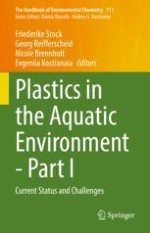2022 | OriginalPaper | Chapter
Analytical Methods for Plastic (Microplastic) Determination in Environmental Samples
Authors : G. Dierkes, T. Lauschke, C. Földi
Published in: Plastics in the Aquatic Environment - Part I
Publisher: Springer International Publishing
Activate our intelligent search to find suitable subject content or patents.
Select sections of text to find matching patents with Artificial Intelligence. powered by
Select sections of text to find additional relevant content using AI-assisted search. powered by
